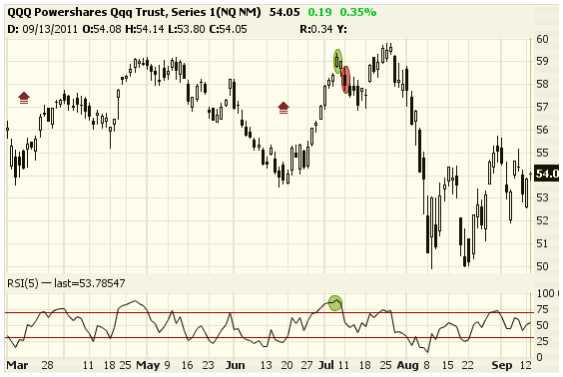Editor’s note: Last week options analyst Andy Crowder hosted a live chat to discuss his "Two Easy Options Strategies for Generating Income in 2012." The response was overwhelming – close to 400 of you tuned in for the hour-long chat, and many of you came equipped with some excellent questions for Andy. While Andy was able to get to many of those questions during the live chat, there were simply so many that he was not able to answer all of them. In today’s Daily Profit, Andy addresses some of your most pressing options questions that went unanswered during our webinar.
 In the meantime, stay tuned for news about Andy’s next options live chat. We’ll have an announcement once the chat event is scheduled in the coming weeks.
In the meantime, stay tuned for news about Andy’s next options live chat. We’ll have an announcement once the chat event is scheduled in the coming weeks.
Why options? The barrier to entry is now next to nothing. Any investor can participate. More products with highly efficient markets are being introduced. These are indeed exciting times in the options arena.
But because options remain so foreign to many, the self-directed investor is hesitant to participate.
Options are considered too complex. Most professional brokers know next to nothing about options. For example, when I worked at Oppenheimer, just one go-to guy among hundreds was considered the specialist. All options questions went through him. No one knew how to use them properly.
And even the people who knew how to use them didn’t know how to use them effectively. The most common strategy, and still the most common strategy today, was buying out-of-the-money calls or puts. It was complete speculation – a trade with a very low probability of success. But the word on the street was that you could make quick money and lots of it. And yes, you could. But due to the lack of a statistical advantage, THE STRATEGY WOULD INEVITABLY FAIL.
Most traders today still use options as pure speculation. They don’t realize the true potential of options. They don’t want to actually think about using an options strategy to gain a true statistical advantage. They would rather guess, just like buying or selling a stock, if the stock or ETF will go up or down. Playing in such a zero sum game is a losing proposition over the long haul.
But quite honestly, that’s perfectly fine with me. Just like most floor traders and market makers, if the retail public is willing to take on a highly speculative trade, I am always willing to sell it to them.
That’s why, in most cases, I want to be the seller of options. I want to bring in credit and allow time decay to work its magic. Every successful options trader will tell you this is the key to becoming a long-term successful options trader.
Now that we’ve reached a period that offers a low barrier to entry, it makes perfect sense to use options to their full advantage. Commissions are low and products are highly liquid. If you use the appropriate products, there is truly no edge now for the market makers.
Now, on to some of your unanswered questions from last week’s live options chat.
Chris: What "simple" strategies do you use?
Andy: I use two options strategies in the Options Advantage portfolio.
The first is a directional strategy of buying calls and puts. The strategy is based on my overbought/oversold indicators.
The second strategy that I employ is a credit spread strategy. Again, the strategy is based on my overbought/oversold indicators.
Both are my bread-and-butter strategies.
Chris: What indicators do you use for your options strategies?
Andy: I keep a list of 30-40 ETFs that have highly liquid options. I prefer using ETFs for a few reasons. They offer some of the most liquid products in the options market. And I don’t have to worry about unforeseen risk, such as bad earnings, that often occur with owning individual stocks.
Again, I just like to keep it simple. Follow what I know. Trade what I am comfortable trading.
Some of you might decide to use the strategies for individual stocks, which is fine. It’s all about your comfort level.
I keep a list of ETFs because I like to follow the short-term, overbought/oversold readings of each on a daily basis.
I do this with the RSI (5). RSI, otherwise known as the "relative strength indicator," is a technical momentum indicator that compares the magnitude of recent gains to recent losses in an attempt to determine overbought and oversold conditions of the ETF.
I patiently wait for a short-term extreme to enter one of the ETFs and then I begin to seriously consider a trade opportunity. Waiting for the opportunity is one of the hardest aspects to learn as a trader. Traders inherently like action. But as I learned long ago from a respected, successful Goldman Sachs bond trader: boring is good, trade like wood.
Opportunities can be made up easier than losses.
Chris: Can you give me an example of how you would use RSI (5) in a trade?
Andy: Certainly.
Let’s go back to June. The market surged for eight straight days starting at the end of the month. The surge lasted until July 7, at which time QQQ (the Nasdaq ETF) had pushed into a short-term overbought extreme.
If you look at the RSI (5) reading in the chart below, you’ll see that a short-term overbought extreme had been hit (green circle). The next step is to make sure my other proprietary indicators line up. If they do, I will fade the move.
Fading just means that I place a trade that opposes the current trend. In this case the move was higher, and therefore I bought puts. If the market had declined sharply and moved into a short-term oversold extreme, I would have bought calls.

The trade: When entering the trade, I always look for a delta between 0.50 and 0.70. This means that for every one-dollar move in the underlying ETF, the option will move between 50 and 70 cents, so I will make $50 to $70 per contract. Moreover, I look for an option price in the $2.50 – $3.00 range. If you are unfamiliar with the term "delta" or the "Greeks" in general, feel free to email me at optionsadvantage@wyattresearch.com.
The reason I chose a delta in the 0.50 – 0.70 range is for risk-management reasons. Choosing an option with a delta of 1.00 is way too risky and potentially fatal if the underlying ETF moves in the opposite direction of your position. A delta below 0.50 would require a large move in the underlying ETF and I don’t want to wait for an extended move.
Remember, this part of the strategy takes advantage of short-term extremes. I do not want to be in a trade for longer than a week if I have to. My average trade lasts 4.7 days in this strategy so choosing an option that requires a large move of more than five days is unrealistic.
So, back to the trade.
With QQQ moving into a short-term extreme on July 11, I bought QQQ puts for $2.77. Two trading days later, I sold the puts for $3.23.
Again, I keep it simple – very simple.
Simple equals boring, and often that does not entice traders. But I am not here for excitement; I am here to provide a sound options strategy that makes people money over the long haul. And that is exactly what the Options Advantage options strategy has done.
With these short-term directional trades, I tend to keep my position size small. When diversified with my credit spread strategy, the Options Advantage portfolio is able to take care of short-term moves while generating monthly income. It’s the best of both worlds.
Chris: What do you expect from the market in 2012, and how do you plan to use that to your advantage as an options trader?
Andy: I try not to guess where the market is headed over the intermediate to long term. It is truly a fool’s game. The crystal-ball approach is basically useless to investors. No one knows where the market is headed over the next year. If they say they do, then you might want to reconsider where you get your information from.
What I do know is that 2012, like every year, will present short-term extremes in the market. As always I will take advantage of these extremes by applying sound, logical options strategies. My approach is mechanical. I patiently wait for short-term extremes, apply the right strategy to fit my assumption on the extreme and then allow time decay or my directional conviction to play out. It is quite simple. My approach is always the same, whether it’s 2012 or 2020.
To learn more about Andy Crowder’s Options Advantage trading service, click here.
 Facebook
Facebook
 Twitter
Twitter